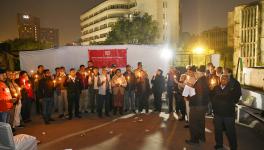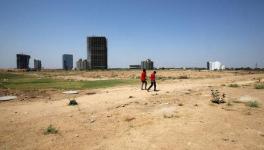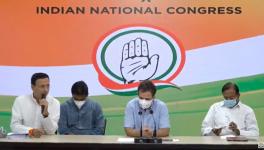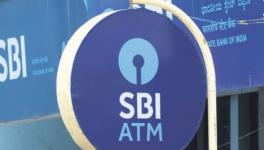Modi Sarkar Puts Everything on Bumper Sale!
Everywhere in the world people got vaccinated against the COVID-19 virus without having to pay a penny, but not in India. Everywhere in the world, historic landmarks that define a nation, that constitute the warp and woof of a nation’s consciousness, are held sacred and left untouched in their original shape, but not in India. Everywhere in the world, public assets that provide basic services, or cultural and educational services, to the people, are virtually free, but no longer in India.
Behind this bizarre Indian exceptionalism is the Narendra Modi government’s peculiar agenda to turn everything into a commodity. Nothing is sacrosanct, nothing is hallowed, nothing transcends the market; everything is for sale.
Consider the three examples mentioned above. Earlier when private hospitals vaccinated people, they demanded Rs 250 for the service, which itself should have been avoided, but was at least small enough to be manageable. Now, private hospitals are being allowed to charge huge amounts, Rs 780 for Covishield, Rs 1,410 for Covaxin and Rs 1,145 for Sputnik V, because they no longer get these vaccines free from the government. By not giving them these vaccines, the government clearly wants to convert the vaccines into commodities.
Likewise, take the Jallianwala Bagh “beautification” project. That tragic occurrence was a defining event in India’s anti-colonial struggle, and hence played a crucial role in the coming into being of a new India. The ground where General Dyer ordered his troops to shoot down peaceful demonstrators until he ran out of ammunition, is hallowed ground for every Indian, and should have been left completely untouched.
For instance, in Goree island off the coast of Dakar in Senegal from where millions of slaves were transported to America, and which had brought tears to the eyes of Nelson Mandela when he had visited it years later, the buildings, the barracks, and the dungeons are left exactly as they were when those heart-rending shipments had occurred.
But, in India, the historic Jallianwala Bagh has been “beautified” by our upstart government, no doubt with an idea, wholly imaginary and misplaced, that this would attract more foreign tourists. Jallianwala Bagh, in short, is being made into a commodity, and the commodity aspect of it has taken precedence over its sacredness for the nation.
Exactly the same mentality was visible in the “beautification” of the original approach via a historic narrow road to the Viswanath temple in Varanasi, for which adjoining very old houses and many small temples were demolished in this ancient city. The idea was to make the Viswanath temple and its immediate environs easily accessible to the tourist, especially the foreign tourist; the idea, in short, was to convert the temple into a commodity.
And now, a range of public assets from railway stations, ports, airports to stadia and roads, are being sought to be “monetised” which means that they would be made into commodities in the hands of private operators. The finance minister has been arguing vehemently that “monetisation” is different from privatisation; but that is sheer sophistry.
“Monetisation” means handing over the asset to private operators for a certain period; even if the asset comes back to the government at the end of that period (there will be a host of issues to be settled at that time regarding the value of investments made in the meantime by the lessee on the asset), it will presumably be handed back either to the same lessee or to someone else for a price. “Monetisation” then would be no different from sale for a sequence of short periods of time, instead of a once-for-all sale; bu,t effectively it would be a sale nonetheless.
In macroeconomic terms, “monetisation” of public assets is no different from running a fiscal deficit for financing larger government expenditure. In the case of a fiscal deficit, the government puts assets (in the form of government securities which are claims upon itself) into the hands of the private sector, and the money it gets in lieu of doing so, is what it spends; in the case of “monetisation” it puts assets (in the form of roads, railway platforms and the like) into the hands of the private sector and what it gets in lieu of doing so is what it spends.
The economic difference at the macroeconomic level, relates only to the nature of the assets the government puts into private hands; otherwise, the consequences of the two ways of financing, through a fiscal deficit and through ‘monetisation’ are exactly identical.
While this is so, what happens later is not the same in the two cases. The macroeconomic consequences of the private sector operating the public asset are far worse than those of a fiscal deficit, since the private sector that has leased in the asset, has done so only to make a profit on it; and for this, it would increase user charges, reduce the wage bill on the asset’s operation, and so on.
These measures amount, effectively, to a rise in the average profit margin in the economy, namely, to a shift from wages to profits. Since the consumption-to-income ratio of wage-earners is much greater than of profit-earners, this means, for any given level of overall investment, a reduction in the level of consumption, and hence aggregate demand.
This mode of financing government spending, therefore, is less expansionary than either a fiscal deficit or a profit tax or a wealth tax as a means of financing government spending. In an economy saddled with massive unutilised capacity as well as unemployment, it is distinctly inferior. This is quite apart from the fact that the regressive income distribution it entails, is reprehensible in itself.
Apart from all these effects, however, this also implies a shift in policy stance that is anti-democratic in a fundamental sense going beyond mere economics. In a modern society, the government provides a range of goods and services, more or less gratis, to the people as a matter of their right, in their capacity as citizens. A whole range of public assets produce such goods and services. The goods and services produced by such assets are generally meant to be enjoyed by people in their capacity as citizens.
There has for long been a dominant view among economists that these goods and services should, as far as possible, be free. A bench provided in the park by the government is meant for everybody to use without any payment. A railway platform is meant for everybody to use, on the payment, at the most, of a nominal sum (for buying a platform ticket). A public museum is meant for everybody to visit, either free of charge or with a nominal payment. True, the government has been compromising on this principle and jacking up most user charges, but even now, the principle that such charges cannot be more than nominal has been more or less accepted.
The absence of a fee, or charging at most a nominal fee, for the goods and services produced by such public assets is a reflection of the fact that users are all equal, and hence co-owners of the asset in their capacity as citizens, on whose behalf the government nominally owns the asset. A large number of public assets, therefore, belong to the public domain, the domain of rights, and hence are meant to be enjoyed by all citizens on an equal footing.
By contrast, the market is intrinsically unequal, where a person’s significance depends upon the magnitude of his or her purchasing power. Shifting a public asset from being run by the government to being run by a private operator, implies, therefore, that the good produced by that asset gets shifted from being in the public domain where everyone enjoys it equally by virtue of being a citizen, to being a commodity where some alone (with higher purchasing power) have access to it. It is a shift from the domain of public goods to the domain of commodities, or from the domain of rights to the domain of purchasing power.
This is an abridgement of democracy, the exclusion of large number of persons from public goods which they had enjoyed as a matter of right. The fact that such “monetisation” entails a regressive distribution of income is well-known and mentioned above. But alongside such regressive distribution, this also means an abridgement of rights, the inability to use a road, the inability to enter a railway platform, which one enjoyed in an unrestricted manner till now.
Every act of commoditisation entails such an exclusion, such a whittling down of the domain of citizenship. Thus, the present government is embarked on a commoditisation spree that would substitute economic apartheid in lieu of equal democratic rights for citizens.
Get the latest reports & analysis with people's perspective on Protests, movements & deep analytical videos, discussions of the current affairs in your Telegram app. Subscribe to NewsClick's Telegram channel & get Real-Time updates on stories, as they get published on our website.
























